Infiniti Q50 thread
#1231
#1233
Lexus Fanatic
A number of new vehicles do it that way...including the Audi A3 I recently reviewed. It is a simple, low-cost way for the manufacturers to integrate the screen into the dash....though I admit there are better ways to do it from a visual standpoint.
#1234
Lexus Champion
For MB to have that horrible set up where the screen looks like a total afterthought, slapped onto the dash (although it looks much worse in the CLA) is a travesty.
#1235
Lead Lap
I've mentioned here several times that this isn't a cost-driven thing. The old double-bubble design that everyone was using wasn't any more expensive. Automakers have switched to this tablet design for visibility reasons. Mercedes has stated that they chose this specific design (vs. BMW/Audi/and now Lexus NX) because it appears to be "floating" when viewed from the driver's seat. And yes, they actually said floating.
#1236
Lexus Fanatic
I've mentioned here several times that this isn't a cost-driven thing. The old double-bubble design that everyone was using wasn't any more expensive. Automakers have switched to this tablet design for visibility reasons. Mercedes has stated that they chose this specific design (vs. BMW/Audi/and now Lexus NX) because it appears to be "floating" when viewed from the driver's seat. And yes, they actually said floating.
Automakers will try and skirt the question or give any excuse in the book on why they cost-cut on designs, hoping that people will actually believe it. Of course, no one can totally read minds, and once in a while, they actually tell the truth. But the point is...........don't believe it just because they happened to say so. Think a little for yourself.

Last edited by mmarshall; 07-24-14 at 01:08 PM.
#1237
Lead Lap
Automakers will try and skirt the question or give any excuse in the book on why they cost-cut on designs, hoping that people will actually believe it. Of course, no one can totally read minds, and once in a while, they actually tell the truth. But the point is...........don't believe it just because they happened to say so. Think a little for yourself. 

If you want to talk about cost cutting, we can talk about how the screen is in the same casing no matter which screen size you get- they just increase the bezel thickness accordingly. It looks really bad if you don't get nav, imo.
I would like to see a cost analysis of the two solutions though, especially knowing the free-standing screens have more expensive screens with better anti-glare characteristics.
Last edited by TangoRed; 07-24-14 at 03:02 PM.
#1238
Lexus Fanatic
I am absolutely thinking for myself. If you want to tell me a motorized screen a la Audi is cheaper than a fixed one like Mercedes, then sure I'm all game to understand there's cost cutting going on there. But the previous-gen method of putting the screen in a hooded area on the dash is still a fixed screen regardless and it raised the dash height.
If you want to talk about cost cutting, we can talk about how the screen is in the same casing no matter which screen size you get- they just increase the bezel thickness accordingly. It looks really bad if you don't get nav, imo.
I would like to see a cost analysis of the two solutions though, especially knowing the free-standing screens have more expensive screens with better anti-glare characteristics.
If you want to talk about cost cutting, we can talk about how the screen is in the same casing no matter which screen size you get- they just increase the bezel thickness accordingly. It looks really bad if you don't get nav, imo.
I would like to see a cost analysis of the two solutions though, especially knowing the free-standing screens have more expensive screens with better anti-glare characteristics.
Well, part of it, too, is not just whether it has a motor or not, but, as you note, the quality of the components within....and whether it was part of the original design or whether it had to be grated on.
And don't misunderstand me. I wasn't specifically saying that you didn't know how to think for yourself. (Sorry if I gave that impression)
 What I meant was that I've heard a lot of P.R. (a lot of it B.S.) over the years from a lot of manufacturer-reps as to why they do things, when the true treason is obvious.
What I meant was that I've heard a lot of P.R. (a lot of it B.S.) over the years from a lot of manufacturer-reps as to why they do things, when the true treason is obvious.
#1239
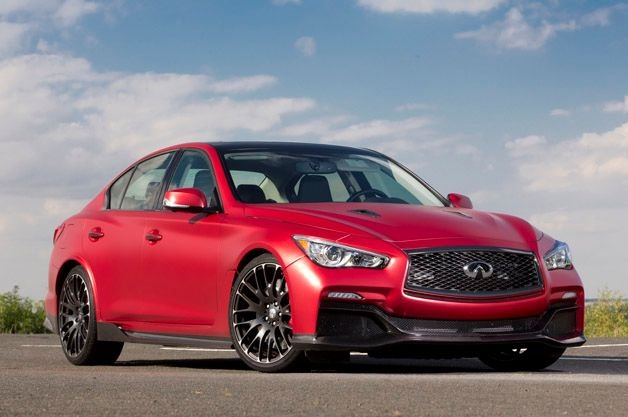
Gallery:
http://www.autoblog.com/photos/infin...photo-2793602/
It only takes about half a lap of the Millbrook Proving Grounds for me to become convinced that Infiniti must build this car.
The sedan I am piloting around the English circuit is a working prototype of the Q50 Eau Rouge Concept that made its world debut at the 2014 Detroit Auto Show earlier this year. As a refresher, the exquisitely painted, burgundy metallic, four-door show car is based on the production Q50, enhanced with Infiniti Red Bull Racing-inspired carbon-fiber bodywork, aerodynamic upgrades and – as we would come to learn at the Geneva Motor Show a few months later – fitted with a beastly twin-turbocharged engine shared with the parent company's spectacular Nissan GT-R.
Despite lacking the concept's gorgeously expensive paint, the vinyl-wrapped red prototype seen here is much more appealing than the static concept, as it is mechanically complete – it can be driven – thus explaining why I have traveled one-third of the way around the world to test this enthusiast-tuned, one-of-a-kind machine at one of Europe's premier testing facilities.
The Q50 Eau Rouge, named after the signature high-speed corner at Belgium's famed Spa-Francorchamps race circuit, is an intriguing program for a number of reasons. First, the Japanese luxury brand has never offered a flagship sport sedan of this magnitude. Second, the push came from Johan de Nysschen – the man tasked with turning Infiniti around who recently announced his departure from the company at the end of the month. Lastly, the working prototype was built by a small team in England, thousands of miles from Infiniti's Hong Kong headquarters, which allowed the program to move unimpeded by coagulating corporate culture. While launching the Eau Rouge program isn't as extreme as renaming all of its models, it would be easy to argue that this is a very radical move for the often-conservative Japanese automaker.

Over the past decade, I have driven a half-dozen or so near-priceless handcrafted prototypes. In every case, the manufacturer has put a warm body in the passenger seat to protect its investment. This time was different, as Infiniti did nothing more than take me for a few familiarization laps of Millbrook in a Q50S Hybrid before setting me free in its Eau Rouge prototype. With the exception of a GoPro camera, which I had requested for the video portion of this story, mine were the only eyes inside the cabin. With a dozen people watching from the tent, and me inside the only of these vehicles in existence, I'll admit I was more than a bit nervous.
The small team tasked with building this prototype were handed a silver metallic US-spec Infiniti Q50S as a donor car last December (even though the concept was still a month from its Detroit debut, the automaker was confident it had something special on its hands, so a working prototype was given an early go-ahead). To initiate the transformation into the Eau Rouge, the sedan's complete powertrain, including its naturally aspirated 3.7-liter V6, rated at 328 horsepower and 269 pound-feet of torque, was pulled. But that was just a portion of the undertaking, as the stock suspension, brakes, bumpers and front seats were all removed, too.
Cosmetically, and with the exception of the aforementioned color, the prototype nearly matches the concept in terms of visual stimulation. The new F1-inspired aero kit is both attractive and functional, but a production version would have a more aggressive decklid spoiler to reduce lift and a slightly different front fascia to allow more cooling air into the engine compartment. The stunning forged alloys fill their fenders very well (it helps that the prototype rides about three-quarters of an inch lower than a stock Q50S). Each wheel is custom made for the prototype, with a black finish and bright machined accents, and each is wrapped in ultra-sticky 255/35ZR20 Pirelli PZero Corsa rubber.
While the exterior boasts an enhanced appearance, the cabin appears mostly stock. From the cockpit, the only noticeable changes are the two very comfortable and supportive bucket racing seats and striking carbon-fiber trim woven with rouge thread. The instrumentation and primary controls are untouched. Infiniti officials hinted that if the vehicle makes it into production, the interior would have unique badging and special trim – and a meatier sport steering wheel.
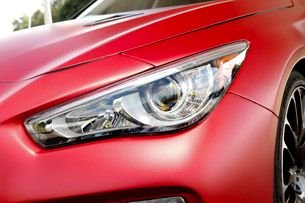
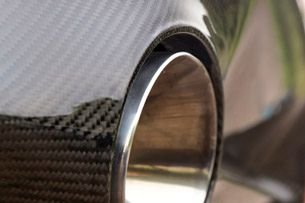
Early in the program, the team discussed three possible engine choices for the Eau Rouge. The easy answer was a retuned 3.7-liter V6, or VQ37VHR, bumped in output, which was already fitted to the Q50 platform – it was axed because it couldn't meet the program's required power output. The next candidate, the burly 5.6-liter V8, or VK56VD, from the Q70 met some horsepower requirements – yet it was dismissed because its truck-based architecture lacked a sports car soul. The last choice, and perhaps the most obvious to an enthusiast, was the perfect candidate – the twin-turbocharged 3.8-liter V6, or VR38DETT, currently shoehorned under the hood of the Nissan GT-R.
The decision may seem like a no-brainer, but fitting it under the hood of a Q50 proved to be a complex task. Although the team had been working on the Eau Rouge from late 2013, it wasn't until after the Detroit Auto Show that they were confident the VR38DETT could be properly packaged to fit within the confines of the sedan, as the GT-R coupe has a slightly longer engine compartment to accommodate the various radiators and intercoolers that the turbocharged V6 requires. (Interesting fact: the Eau Rouge concept displayed at the January NAIAS didn't have an engine at all, which explains why de Nysschen hinted at a power output at the time but didn't reveal a specific powerplant until March's Geneva Motor Show.)
Seated comfortably behind the steering wheel within the Q50's roomy cabin, the engine fires quickly with the press of the start/stop button. Unlike many engine transplants that reveal themselves with rough idles, misfires or other idiosyncrasies, the GT-R's wondrous heart takes direction from an Infiniti performance ECU and purrs smoothly at a standstill. It also arrives with its own unique soundtrack, thanks to an emissions-legal exhaust system that eliminates the GT-R's crossover in favor of two separate exhaust pipes, each of which serve a bank of cylinders before exiting through custom tips in the rear carbon-fiber fascia.
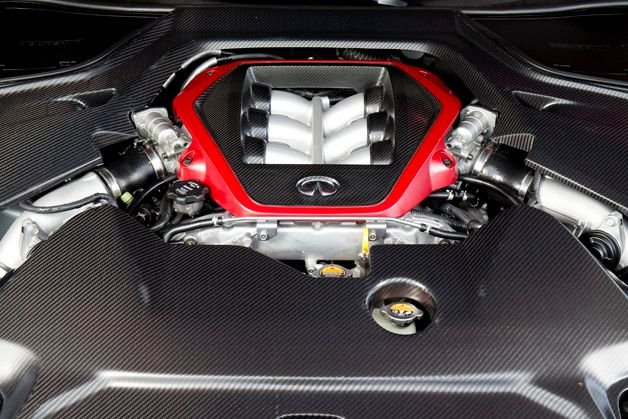
Redesigning the exhaust was a piece of cake compared to the monumental task of finding a suitable transmission. As you may recall, the two-seat GT-R is fit with a seven-speed dual-clutch transaxle that resides beneath the cabin aft of the passengers. From the outset, it was obvious that the transaxle would not fit in the chassis of the Q50. With that gearbox out of the question, the team bolted a seven-speed torque-converter automatic, borrowed from the Q70 5.6, directly to the back of the VR38DETT – the first time a transmission has been bolted directly to this engine, says Infiniti.
Mounting this transmission from a luxury sedan wasn't the only packaging-forced compromise, as the GT-R's celebrated performance-oriented mechanical ATESSA E-TS all-wheel-drive system was also eliminated and replaced with Infiniti's Intelligent AWD from the Q70. The team admits that this is a temporary solution – we can expect a different transmission and a performance-oriented AWD solution if the Eau Rouge makes it into production. The prototype's turbocharged 3.8-liter is tuned to 560 horsepower and 442 pound-feet of torque, a level of power that understandably puts a lot of stress on the gearbox. To extend its life, shifts have been electronically slowed to reduce driveline shock, and I have been asked to shift with the column-mounted paddle shifters. No problem.
Millbrook's "Hill Route" is best described as an undulating strip of two-lane road that rolls up and down (some grades exceed 20 percent) through the English hills at the proving grounds. The pavement is not particularly smooth, there is no runoff and the steel guardrails are uncomfortably close to the edge of the road (if given the opportunity, I'd much prefer to run Southern California's public Mulholland Highway, which is wider, smoother, and lacks the intimidating, paint-marring barriers).
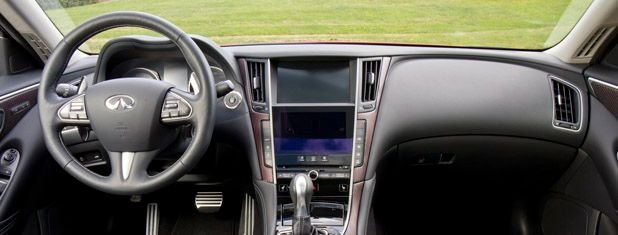
With the gearbox in manual mode and the Infiniti team taking shelter in their air-conditioned tent, I turn onto the test course and goose the accelerator. Despite a curb weight of 4,023 pounds (about 150 pounds more than the heavyweight GT-R), the Eau Rouge blasts forward with the sort of accelerative force that would leave every single model in Infiniti's 24-year history staring dumbfounded at its rapidly disappearing LED taillights. (When prodded for numbers, the on-site engineers estimate a 0-60 blast of "high three seconds" and a top speed "in excess of 180 miles per hour.")
Seconds later, I enter the first corner. The Eau Rouge has a new electric power steering rack, another adjustment to accommodate the engine, with software that still needs a bit of tweaking (it feels a bit light at high speeds). Regardless, initial turn-in is quick, and the sedan hunkers down as its front tires bite tenaciously.
Mid-corner stability is very good, with much of credit going to the prototype's adjustable KW coilover suspension, which does its work accompanied by thick upgraded anti-roll bars. The pair do a commendable job keeping the chassis composed and body roll nearly imperceptible. At least for circuit use, the suspension tuning is nearly spot-on, with the prototype never bottoming out or having a tire rub on a fender. (Don't get too excited about the race-ready coilovers, however, as they will likely get replaced by an adaptive system if the vehicle is produced.)
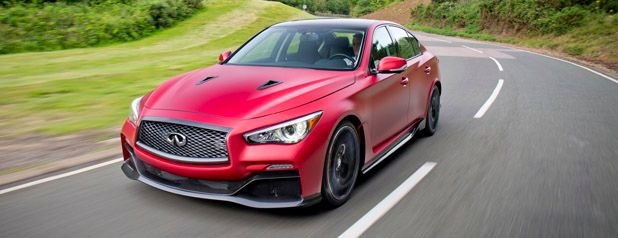
Thanks to all-wheel drive, all that power can be put down early. But doing so also shows the limitations of the Infiniti's inclement weather AWD system, which has been tuned in the Eau Rouge for a 50/50 torque distribution (most performance vehicles have a 40/60 torque split for rear-biased driving dynamics). The prototype pulls cleanly out of the corners, but there are several instances where I want the front tires to do less pulling and more steering. The overworked rubber under the nose would lose grip on some of the most challenging sections, resulting in understeer that made the stability control system very, very nervous.
The Millbrook course has plenty of steep hills, and what goes up must come down. But nothing is more reassuring than knowing the Eau Rouge is fitted with the GT-R's standard brake package, which includes six-piston monobloc front calipers and four-piston monobloc rear calipers over large ventilated and drilled steel rotors. At the bottom of each grade, I slammed the brake pedal in anger, and the system showed no sign of protest whether from noise or heat-induced fade. The concept's stoppers are, quite simply, unflappable.
Lap after lap, the Eau Rouge flew up and down over Millbrook's Hill Route. I was constantly reminded – audibly and physically – of the power packaged under its hood that completely transforms this Q50S donor. An additional 232 horsepower and gobs more torque will do that. While many will compare the "four-door GT-R" prototype to a BMW M3, Mercedes-Benz C63 AMG or an Audi S4, those cars are somewhat smaller in stature and wheelbase, factors that make them a bit more agile and tossable than the still-compact Infiniti. Based on my drive of the Eau Rouge concept, I'd argue that a properly sorted production model would drive more like a fierce – and worthy – competitor to the slightly larger M5, E63 AMG, S6 and upcoming CTS-V.

The Eau Rouge prototype circled the British proving grounds until I was tired and dizzy. Earlier in the day, I had made it a point to not leave the course until the Eau Rouge had proven itself to me, and it had, superbly. The concept's best attributes are its chassis, engine, brakes, tires and suspension. Areas that still need a bit of work include the transmission and steering, shortcomings Infiniti acknowledges and is madly engineering and tuning to get right. Despite a few rough edges that still need a bit of polishing, I really enjoyed driving the prototype.
I flew to England expecting to pamper a fragile kit-based vehicle with a laundry list of restrictions and a babysitter beside me. Instead, I was tossed the key and offered carte blanche opportunity to test on a challenging track without a minder in the passenger seat. The unrestricted access to the work-in-progress convinced me that Infiniti's Eau Rouge program has solid legs. The sport sedan will be a very competitive athlete – if it's given the opportunity.
As of now, the program's future is undecided and the Eau Rouge's strongest supporter, Johan de Nysschen, has one foot out the door. Yet the team insists there is plenty of internal momentum to see it through to production as a possible 2016 model (likely arriving with a different name). Without question, the Infiniti model range needs a production version of the Eau Rouge. Greenlighting the program would give the automaker a technically advanced halo model capable of challenging the world's best sedans. A low-volume production version would add character to a model lineup in need of more visual excitement and technical innovation, all while setting performance benchmarks that would keep the company in the public eye.
Infiniti has struggled for nearly a quarter century looking for an identity – a production version of the Eau Rouge could be a big, tangible step towards finding itself.
http://www.autoblog.com/2014/07/28/2...-review-video/
#1240
Lexus Fanatic
iTrader: (20)
wow, what a beast. hope they build it.
#1242
Lexus Fanatic
iTrader: (1)
Making The Case To Build A Brand-Defining Sports Car
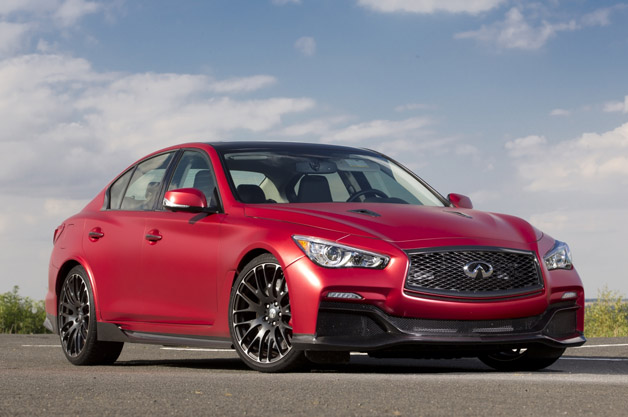
Click here to view photo gallery

Click here to view photo gallery
It only takes about half a lap of the Millbrook Proving Grounds for me to become convinced that Infiniti must build this car.
The sedan I am piloting around the English circuit is a working prototype of the Q50 Eau Rouge Concept that made its world debut at the 2014 Detroit Auto Show earlier this year. As a refresher, the exquisitely painted, burgundy metallic, four-door show car is based on the production Q50, enhanced with Infiniti Red Bull Racing-inspired carbon-fiber bodywork, aerodynamic upgrades and – as we would come to learn at the Geneva Motor Show a few months later – fitted with a beastly twin-turbocharged engine shared with the parent company's spectacular Nissan GT-R.
Despite lacking the concept's gorgeously expensive paint, the vinyl-wrapped red prototype seen here is much more appealing than the static concept, as it is mechanically complete – it can be driven – thus explaining why I have traveled one-third of the way around the world to test this enthusiast-tuned, one-of-a-kind machine at one of Europe's premier testing facilities.
The Q50 Eau Rouge, named after the signature high-speed corner at Belgium's famed Spa-Francorchamps race circuit, is an intriguing program for a number of reasons. First, the Japanese luxury brand has never offered a flagship sport sedan of this magnitude. Second, the push came from Johan de Nysschen – the man tasked with turning Infiniti around who recently announced his departure from the company at the end of the month. Lastly, the working prototype was built by a small team in England, thousands of miles from Infiniti's Hong Kong headquarters, which allowed the program to move unimpeded by coagulating corporate culture. While launching the Eau Rouge program isn't as extreme as renaming all of its models, it would be easy to argue that this is a very radical move for the often-conservative Japanese automaker.
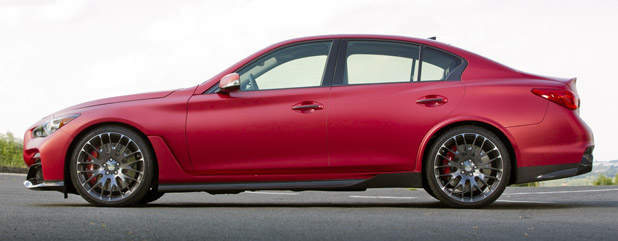
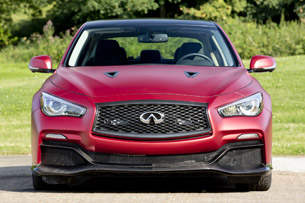
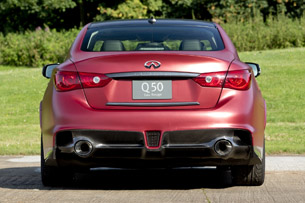
Over the past decade, I have driven a half-dozen or so near-priceless handcrafted prototypes. In every case, the manufacturer has put a warm body in the passenger seat to protect its investment. This time was different, as Infiniti did nothing more than take me for a few familiarization laps of Millbrook in a Q50S Hybrid before setting me free in its Eau Rouge prototype. With the exception of a GoPro camera, which I had requested for the video portion of this story, mine were the only eyes inside the cabin. With a dozen people watching from the tent, and me inside the only of these vehicles in existence, I'll admit I was more than a bit nervous.
The small team tasked with building this prototype were handed a silver metallic US-spec Infiniti Q50S as a donor car last December (even though the concept was still a month from its Detroit debut, the automaker was confident it had something special on its hands, so a working prototype was given an early go-ahead). To initiate the transformation into the Eau Rouge, the sedan's complete powertrain, including its naturally aspirated 3.7-liter V6, rated at 328 horsepower and 269 pound-feet of torque, was pulled. But that was just a portion of the undertaking, as the stock suspension, brakes, bumpers and front seats were all removed, too.
Cosmetically, and with the exception of the aforementioned color, the prototype nearly matches the concept in terms of visual stimulation. The new F1-inspired aero kit is both attractive and functional, but a production version would have a more aggressive decklid spoiler to reduce lift and a slightly different front fascia to allow more cooling air into the engine compartment. The stunning forged alloys fill their fenders very well (it helps that the prototype rides about three-quarters of an inch lower than a stock Q50S). Each wheel is custom made for the prototype, with a black finish and bright machined accents, and each is wrapped in ultra-sticky 255/35ZR20 Pirelli PZero Corsa rubber.
While the exterior boasts an enhanced appearance, the cabin appears mostly stock. From the cockpit, the only noticeable changes are the two very comfortable and supportive bucket racing seats and striking carbon-fiber trim woven with rouge thread. The instrumentation and primary controls are untouched. Infiniti officials hinted that if the vehicle makes it into production, the interior would have unique badging and special trim – and a meatier sport steering wheel.

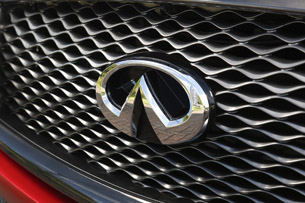
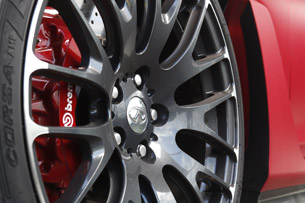
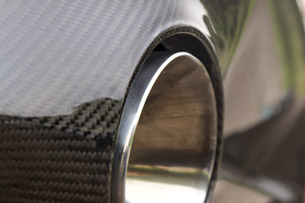
Early in the program, the team discussed three possible engine choices for the Eau Rouge. The easy answer was a retuned 3.7-liter V6, or VQ37VHR, bumped in output, which was already fitted to the Q50 platform – it was axed because it couldn't meet the program's required power output. The next candidate, the burly 5.6-liter V8, or VK56VD, from the Q70 met some horsepower requirements – yet it was dismissed because its truck-based architecture lacked a sports car soul. The last choice, and perhaps the most obvious to an enthusiast, was the perfect candidate – the twin-turbocharged 3.8-liter V6, or VR38DETT, currently shoehorned under the hood of the Nissan GT-R.
The decision may seem like a no-brainer, but fitting it under the hood of a Q50 proved to be a complex task. Although the team had been working on the Eau Rouge from late 2013, it wasn't until after the Detroit Auto Show that they were confident the VR38DETT could be properly packaged to fit within the confines of the sedan, as the GT-R coupe has a slightly longer engine compartment to accommodate the various radiators and intercoolers that the turbocharged V6 requires. (Interesting fact: the Eau Rouge concept displayed at the January NAIAS didn't have an engine at all, which explains why de Nysschen hinted at a power output at the time but didn't reveal a specific powerplant until March's Geneva Motor Show.)
Seated comfortably behind the steering wheel within the Q50's roomy cabin, the engine fires quickly with the press of the start/stop button. Unlike many engine transplants that reveal themselves with rough idles, misfires or other idiosyncrasies, the GT-R's wondrous heart takes direction from an Infiniti performance ECU and purrs smoothly at a standstill. It also arrives with its own unique soundtrack, thanks to an emissions-legal exhaust system that eliminates the GT-R's crossover in favor of two separate exhaust pipes, each of which serve a bank of cylinders before exiting through custom tips in the rear carbon-fiber fascia.
The sedan I am piloting around the English circuit is a working prototype of the Q50 Eau Rouge Concept that made its world debut at the 2014 Detroit Auto Show earlier this year. As a refresher, the exquisitely painted, burgundy metallic, four-door show car is based on the production Q50, enhanced with Infiniti Red Bull Racing-inspired carbon-fiber bodywork, aerodynamic upgrades and – as we would come to learn at the Geneva Motor Show a few months later – fitted with a beastly twin-turbocharged engine shared with the parent company's spectacular Nissan GT-R.
Despite lacking the concept's gorgeously expensive paint, the vinyl-wrapped red prototype seen here is much more appealing than the static concept, as it is mechanically complete – it can be driven – thus explaining why I have traveled one-third of the way around the world to test this enthusiast-tuned, one-of-a-kind machine at one of Europe's premier testing facilities.
The Q50 Eau Rouge, named after the signature high-speed corner at Belgium's famed Spa-Francorchamps race circuit, is an intriguing program for a number of reasons. First, the Japanese luxury brand has never offered a flagship sport sedan of this magnitude. Second, the push came from Johan de Nysschen – the man tasked with turning Infiniti around who recently announced his departure from the company at the end of the month. Lastly, the working prototype was built by a small team in England, thousands of miles from Infiniti's Hong Kong headquarters, which allowed the program to move unimpeded by coagulating corporate culture. While launching the Eau Rouge program isn't as extreme as renaming all of its models, it would be easy to argue that this is a very radical move for the often-conservative Japanese automaker.



Over the past decade, I have driven a half-dozen or so near-priceless handcrafted prototypes. In every case, the manufacturer has put a warm body in the passenger seat to protect its investment. This time was different, as Infiniti did nothing more than take me for a few familiarization laps of Millbrook in a Q50S Hybrid before setting me free in its Eau Rouge prototype. With the exception of a GoPro camera, which I had requested for the video portion of this story, mine were the only eyes inside the cabin. With a dozen people watching from the tent, and me inside the only of these vehicles in existence, I'll admit I was more than a bit nervous.
The small team tasked with building this prototype were handed a silver metallic US-spec Infiniti Q50S as a donor car last December (even though the concept was still a month from its Detroit debut, the automaker was confident it had something special on its hands, so a working prototype was given an early go-ahead). To initiate the transformation into the Eau Rouge, the sedan's complete powertrain, including its naturally aspirated 3.7-liter V6, rated at 328 horsepower and 269 pound-feet of torque, was pulled. But that was just a portion of the undertaking, as the stock suspension, brakes, bumpers and front seats were all removed, too.
Cosmetically, and with the exception of the aforementioned color, the prototype nearly matches the concept in terms of visual stimulation. The new F1-inspired aero kit is both attractive and functional, but a production version would have a more aggressive decklid spoiler to reduce lift and a slightly different front fascia to allow more cooling air into the engine compartment. The stunning forged alloys fill their fenders very well (it helps that the prototype rides about three-quarters of an inch lower than a stock Q50S). Each wheel is custom made for the prototype, with a black finish and bright machined accents, and each is wrapped in ultra-sticky 255/35ZR20 Pirelli PZero Corsa rubber.
While the exterior boasts an enhanced appearance, the cabin appears mostly stock. From the cockpit, the only noticeable changes are the two very comfortable and supportive bucket racing seats and striking carbon-fiber trim woven with rouge thread. The instrumentation and primary controls are untouched. Infiniti officials hinted that if the vehicle makes it into production, the interior would have unique badging and special trim – and a meatier sport steering wheel.




Early in the program, the team discussed three possible engine choices for the Eau Rouge. The easy answer was a retuned 3.7-liter V6, or VQ37VHR, bumped in output, which was already fitted to the Q50 platform – it was axed because it couldn't meet the program's required power output. The next candidate, the burly 5.6-liter V8, or VK56VD, from the Q70 met some horsepower requirements – yet it was dismissed because its truck-based architecture lacked a sports car soul. The last choice, and perhaps the most obvious to an enthusiast, was the perfect candidate – the twin-turbocharged 3.8-liter V6, or VR38DETT, currently shoehorned under the hood of the Nissan GT-R.
The decision may seem like a no-brainer, but fitting it under the hood of a Q50 proved to be a complex task. Although the team had been working on the Eau Rouge from late 2013, it wasn't until after the Detroit Auto Show that they were confident the VR38DETT could be properly packaged to fit within the confines of the sedan, as the GT-R coupe has a slightly longer engine compartment to accommodate the various radiators and intercoolers that the turbocharged V6 requires. (Interesting fact: the Eau Rouge concept displayed at the January NAIAS didn't have an engine at all, which explains why de Nysschen hinted at a power output at the time but didn't reveal a specific powerplant until March's Geneva Motor Show.)
Seated comfortably behind the steering wheel within the Q50's roomy cabin, the engine fires quickly with the press of the start/stop button. Unlike many engine transplants that reveal themselves with rough idles, misfires or other idiosyncrasies, the GT-R's wondrous heart takes direction from an Infiniti performance ECU and purrs smoothly at a standstill. It also arrives with its own unique soundtrack, thanks to an emissions-legal exhaust system that eliminates the GT-R's crossover in favor of two separate exhaust pipes, each of which serve a bank of cylinders before exiting through custom tips in the rear carbon-fiber fascia.
#1243
Lexus Fanatic
iTrader: (1)
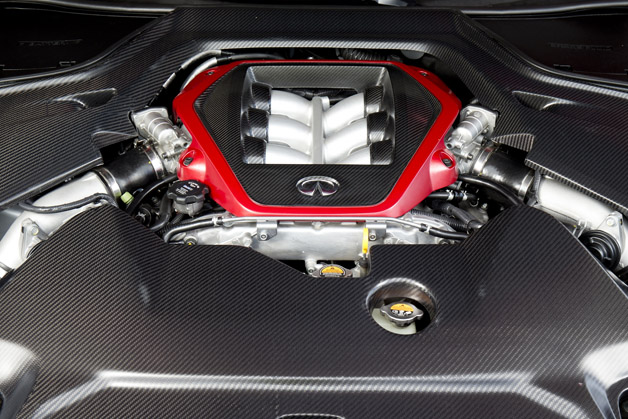
Redesigning the exhaust was a piece of cake compared to the monumental task of finding a suitable transmission. As you may recall, the two-seat GT-R is fit with a seven-speed dual-clutch transaxle that resides beneath the cabin aft of the passengers. From the outset, it was obvious that the transaxle would not fit in the chassis of the Q50. With that gearbox out of the question, the team bolted a seven-speed torque-converter automatic, borrowed from the Q70 5.6, directly to the back of the VR38DETT – the first time a transmission has been bolted directly to this engine, says Infiniti.
Mounting this transmission from a luxury sedan wasn't the only packaging-forced compromise, as the GT-R's celebrated performance-oriented mechanical ATESSA E-TS all-wheel-drive system was also eliminated and replaced with Infiniti's Intelligent AWD from the Q70. The team admits that this is a temporary solution – we can expect a different transmission and a performance-oriented AWD solution if the Eau Rouge makes it into production. The prototype's turbocharged 3.8-liter is tuned to 560 horsepower and 442 pound-feet of torque, a level of power that understandably puts a lot of stress on the gearbox. To extend its life, shifts have been electronically slowed to reduce driveline shock, and I have been asked to shift with the column-mounted paddle shifters. No problem.
Millbrook's "Hill Route" is best described as an undulating strip of two-lane road that rolls up and down (some grades exceed 20 percent) through the English hills at the proving grounds. The pavement is not particularly smooth, there is no runoff and the steel guardrails are uncomfortably close to the edge of the road (if given the opportunity, I'd much prefer to run Southern California's public Mulholland Highway, which is wider, smoother, and lacks the intimidating, paint-marring barriers).
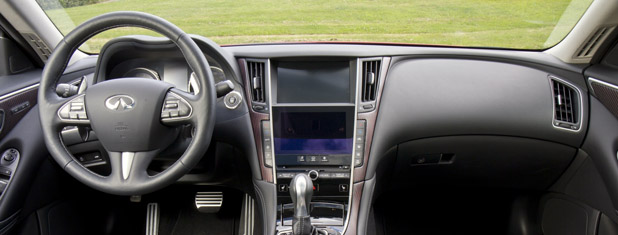
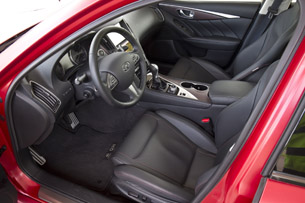
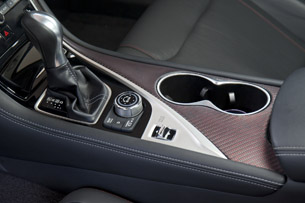
With the gearbox in manual mode and the Infiniti team taking shelter in their air-conditioned tent, I turn onto the test course and goose the accelerator. Despite a curb weight of 4,023 pounds (about 150 pounds more than the heavyweight GT-R), the Eau Rouge blasts forward with the sort of accelerative force that would leave every single model in Infiniti's 24-year history staring dumbfounded at its rapidly disappearing LED taillights. (When prodded for numbers, the on-site engineers estimate a 0-60 blast of "high three seconds" and a top speed "in excess of 180 miles per hour.")
Seconds later, I enter the first corner. The Eau Rouge has a new electric power steering rack, another adjustment to accommodate the engine, with software that still needs a bit of tweaking (it feels a bit light at high speeds). Regardless, initial turn-in is quick, and the sedan hunkers down as its front tires bite tenaciously.
Mid-corner stability is very good, with much of credit going to the prototype's adjustable KW coilover suspension, which does its work accompanied by thick upgraded anti-roll bars. The pair do a commendable job keeping the chassis composed and body roll nearly imperceptible. At least for circuit use, the suspension tuning is nearly spot-on, with the prototype never bottoming out or having a tire rub on a fender. (Don't get too excited about the race-ready coilovers, however, as they will likely get replaced by an adaptive system if the vehicle is produced.)
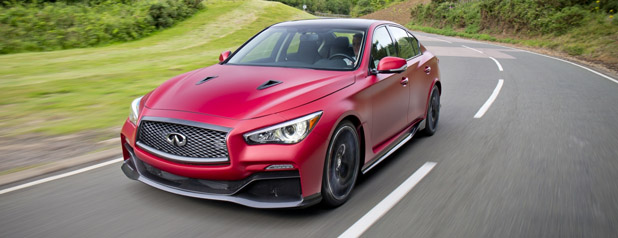
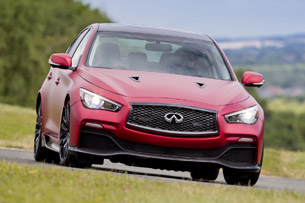
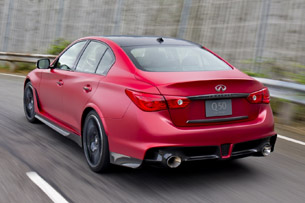
Thanks to all-wheel drive, all that power can be put down early. But doing so also shows the limitations of the Infiniti's inclement weather AWD system, which has been tuned in the Eau Rouge for a 50/50 torque distribution (most performance vehicles have a 40/60 torque split for rear-biased driving dynamics). The prototype pulls cleanly out of the corners, but there are several instances where I want the front tires to do less pulling and more steering. The overworked rubber under the nose would lose grip on some of the most challenging sections, resulting in understeer that made the stability control system very, very nervous.
The Millbrook course has plenty of steep hills, and what goes up must come down. But nothing is more reassuring than knowing the Eau Rouge is fitted with the GT-R's standard brake package, which includes six-piston monobloc front calipers and four-piston monobloc rear calipers over large ventilated and drilled steel rotors. At the bottom of each grade, I slammed the brake pedal in anger, and the system showed no sign of protest whether from noise or heat-induced fade. The concept's stoppers are, quite simply, unflappable.
Lap after lap, the Eau Rouge flew up and down over Millbrook's Hill Route. I was constantly reminded – audibly and physically – of the power packaged under its hood that completely transforms this Q50S donor. An additional 232 horsepower and gobs more torque will do that. While many will compare the "four-door GT-R" prototype to a BMW M3, Mercedes-Benz C63 AMG or an Audi S4, those cars are somewhat smaller in stature and wheelbase, factors that make them a bit more agile and tossable than the still-compact Infiniti. Based on my drive of the Eau Rouge concept, I'd argue that a properly sorted production model would drive more like a fierce – and worthy – competitor to the slightly larger M5, E63 AMG, S6 and upcoming CTS-V.
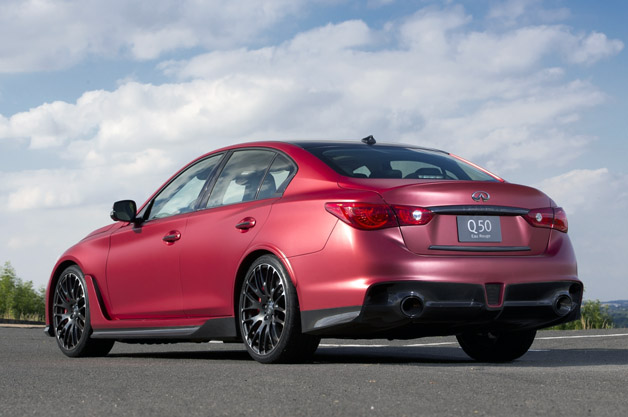
The Eau Rouge prototype circled the British proving grounds until I was tired and dizzy. Earlier in the day, I had made it a point to not leave the course until the Eau Rouge had proven itself to me, and it had, superbly. The concept's best attributes are its chassis, engine, brakes, tires and suspension. Areas that still need a bit of work include the transmission and steering, shortcomings Infiniti acknowledges and is madly engineering and tuning to get right. Despite a few rough edges that still need a bit of polishing, I really enjoyed driving the prototype.
I flew to England expecting to pamper a fragile kit-based vehicle with a laundry list of restrictions and a babysitter beside me. Instead, I was tossed the key and offered carte blanche opportunity to test on a challenging track without a minder in the passenger seat. The unrestricted access to the work-in-progress convinced me that Infiniti's Eau Rouge program has solid legs. The sport sedan will be a very competitive athlete – if it's given the opportunity.
As of now, the program's future is undecided and the Eau Rouge's strongest supporter, Johan de Nysschen, has one foot out the door. Yet the team insists there is plenty of internal momentum to see it through to production as a possible 2016 model (likely arriving with a different name). Without question, the Infiniti model range needs a production version of the Eau Rouge. Greenlighting the program would give the automaker a technically advanced halo model capable of challenging the world's best sedans. A low-volume production version would add character to a model lineup in need of more visual excitement and technical innovation, all while setting performance benchmarks that would keep the company in the public eye.
Infiniti has struggled for nearly a quarter century looking for an identity – a production version of the Eau Rouge could be a big, tangible step towards finding itself.
Engine: Twin-Turbo 3.8L V6
Power: 560 HP / 442 LB-FT
Transmission: 7-Speed Auto
0-60 Time: 3.8 Second (est)
Top Speed: 185 MPH (est)
Drivetrain: All-Wheel Drive
Curb Weight: 4,023 LBS
Seating: 2+3
As-Tested Price: Prototype
#1244
Lexus Fanatic
iTrader: (1)
Q50 Eau Rouge: Using the Q50 as its base architecture, the proposed carbon fiber-trimmed Eau Rouge would be to Infiniti what the low-volume GT-R racer is to the mass-market Nissan brand. If Infiniti goes ahead with the $100,000-plus image car in 2016 or 2017, it would even use the GT-R's hand-built twin-turbo 3.8-liter, 560-hp V-6 engine. Discussing the plan publicly a week before he left the company, de Nysschen said Infiniti expects to sell just 500 Eau Rouges a year.
#1245
Pole Position
Join Date: Mar 2014
Location: New York
Posts: 262
Likes: 0
Received 0 Likes
on
0 Posts

This will certainly be the new benchmark in that class. Nothing will be able to touch it. Perhaps not even those models in the class above it.


